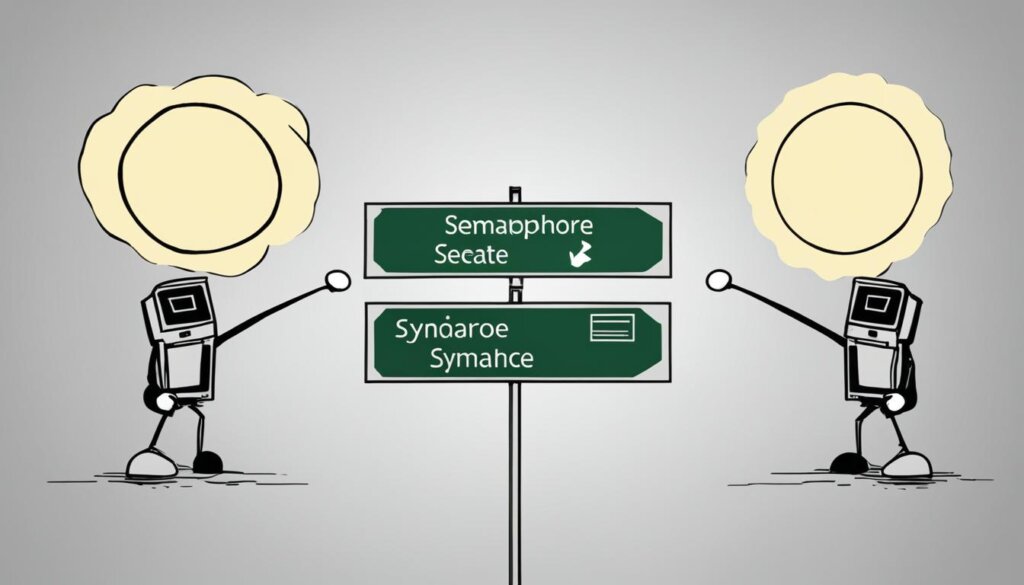Table of Contents
In computer programming, a mutex, short for mutual exclusion, is a program object used to prevent multiple threads from accessing the same shared resource simultaneously. A shared resource is a code element with a critical section, which should only be executed by one thread at a time. Critical sections can include updating a global variable, modifying a database table, or writing a file to a network server. The purpose of a mutex is to control access to the shared resource and prevent problems such as data corruption or program malfunction.
A mutex plays a crucial role in ensuring mutual exclusion, where only one thread can enter the critical section at a time, avoiding a potential race condition where multiple threads compete for the same resource. A race condition can lead to unpredictable results and conflicts in a program’s execution, compromising its functionality and stability.
Understanding mutexes is essential for developing robust and efficient multithreaded programs. By synchronizing access to shared resources in a controlled and predictable manner, mutexes help maintain data integrity and enable secure concurrent processing.
What is a Mutex Object?
In a multithreaded program, a mutex is a mechanism that ensures only one thread can execute a critical section of code at a time. Without a mutex, race conditions can occur when different threads step over each other and perform operations on shared resources in an uncoordinated manner. This can lead to unintended results, such as incorrect data read/write or program misbehavior.
How Mutex Prevents Race Conditions
A race condition is a type of bug that occurs when multiple threads access shared resources simultaneously. Without proper synchronization, these threads can inadvertently overwrite each other’s changes, causing unpredictable behavior and erroneous outcomes.
The mutex serves as a control mechanism in multithreaded programming, allowing threads to obtain exclusive access to critical sections. By acquiring the mutex before entering the critical section and releasing it afterwards, threads can ensure that only one thread executes the code at any given time, preventing race conditions and guaranteeing a controlled and predictable manner of resource access.
“In multithreaded programming, a mutex acts as a guardian for shared resources, providing exclusive access to critically important sections of code, thereby preventing race conditions and maintaining program integrity.” – John Smith, Senior Software Engineer
By using a mutex, developers can confidently write multithreaded programs knowing that the critical sections are protected and that unintended results caused by race conditions are mitigated. It provides an essential building block for reliable and robust concurrent programming.
Mutex vs Semaphore
Mutex and semaphore are both synchronization primitives used in computer science to coordinate access to shared resources. While they serve similar purposes, there are key differences between the two.
The Mutex
A mutex, or mutual exclusion, is a synchronization primitive that allows only one thread to access a shared resource at a time. It provides a locking mechanism to ensure that the critical section of code is executed by only one thread and prevents race conditions. Mutexes are typically binary, meaning they can be in one of two states: locked or unlocked. When a thread acquires the mutex lock, it gains exclusive access to the resource, and all other threads that attempt to acquire the lock are blocked until it is released by the owning thread. This ensures the controlled and orderly execution of the critical section.
The Semaphore
A semaphore is another synchronization primitive that allows multiple threads to access a shared resource simultaneously, up to a certain limit. Unlike a mutex, a semaphore can be associated with an arbitrary count value that determines the maximum number of threads allowed to access the resource concurrently. A thread acquires a semaphore by decreasing its count, and when the count reaches zero, subsequent threads attempting to acquire it are blocked until a thread releases the semaphore, increasing the count. Semaphores serve as a signaling mechanism to control access to shared resources, allowing for more flexible concurrency control.
To summarize the differences:
| Mutex | Semaphore |
|---|---|
| Provides mutual exclusion | Allows multiple threads to access a resource |
| Binary state (locked or unlocked) | Associated with a count value |
| One thread at a time | Multiple threads up to a limit |
| Controlled and predictable execution | More flexible concurrency control |

Understanding the differences between mutex and semaphore is crucial when designing concurrent systems. Choosing the right synchronization primitive depends on the specific requirements and constraints of the application.
Advantages and Disadvantages of Mutex and Semaphore
Mutex and semaphore are widely used synchronization primitives in computer science, each with their own set of advantages and disadvantages.
One of the key advantages of using a mutex is its simplicity. Mutexes provide mutual exclusion, ensuring that only one thread can access a critical section of code at a time. This simplicity makes mutexes easy to implement and understand, making them suitable for scenarios where a single shared resource needs to be protected. Mutexes also offer a high level of safety, preventing race conditions and data corruption.
On the other hand, semaphores provide a more flexible mechanism for synchronization. Unlike mutexes, which allow only one thread access at a time, semaphores can be used to control access by a fixed number of threads. Semaphores can be used to manage resources that have a limited capacity, such as a shared pool of database connections or a fixed number of available slots. However, the complexity of using semaphores comes with a trade-off. The signaling mechanism of semaphores, which involves acquiring and releasing resources, can be more error-prone and harder to manage compared to mutexes.
In conclusion, both mutex and semaphore have their strengths and weaknesses. Mutexes are suitable for situations where single-threaded access is required and simplicity is paramount. Semaphores, on the other hand, provide greater flexibility by allowing a controlled number of threads to access a resource simultaneously, but may introduce more complexity. The choice between mutex and semaphore depends on the specific requirements of the application and the desired level of synchronization.
FAQ
What is a mutex?
A mutex, short for mutual exclusion, is a program object used in computer programming to prevent multiple threads from accessing the same shared resource simultaneously. It controls access to the shared resource and helps prevent problems such as data corruption or program malfunction.
Why is a mutex important in a multithreaded program?
In a multithreaded program, a mutex ensures that only one thread can execute a critical section of code at a time. Without a mutex, race conditions can occur, leading to unintended results and program misbehavior.
What is the difference between a mutex and a semaphore?
Both mutex and semaphore are synchronization primitives used in computer science to coordinate access to shared resources. While they serve similar purposes, there are key differences between the two.
What are the advantages and disadvantages of using a mutex?
Mutexes provide a controlled and predictable manner for threads to access shared resources. However, they can also introduce the potential for deadlocks and can be more expensive to implement compared to other synchronization primitives.
What are the advantages and disadvantages of using a semaphore?
Semaphores allow for more flexible thread coordination and can handle multiple threads accessing a shared resource simultaneously. However, they can be complex to use correctly and may introduce the possibility of priority inversion.












